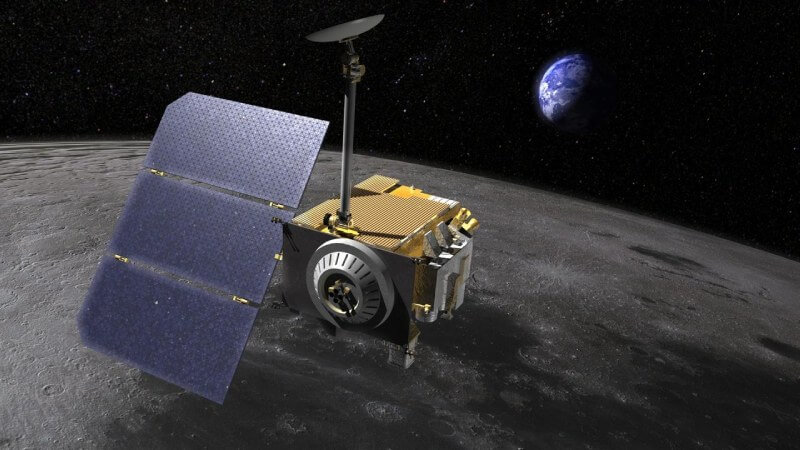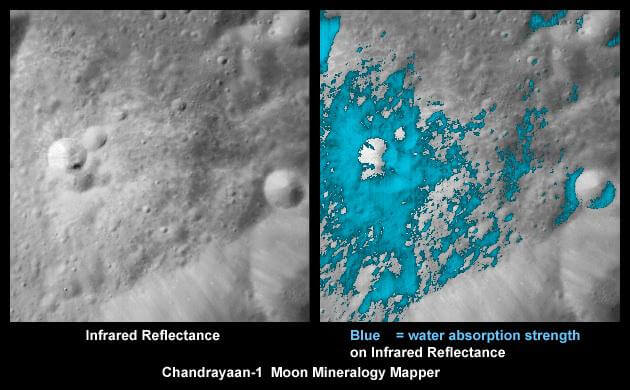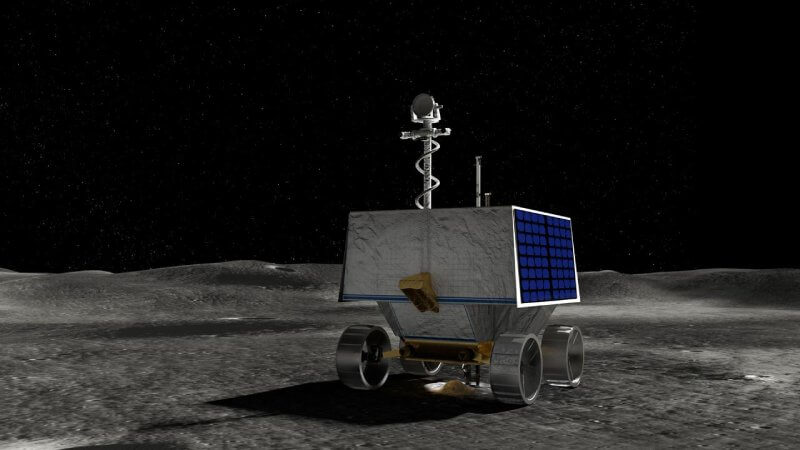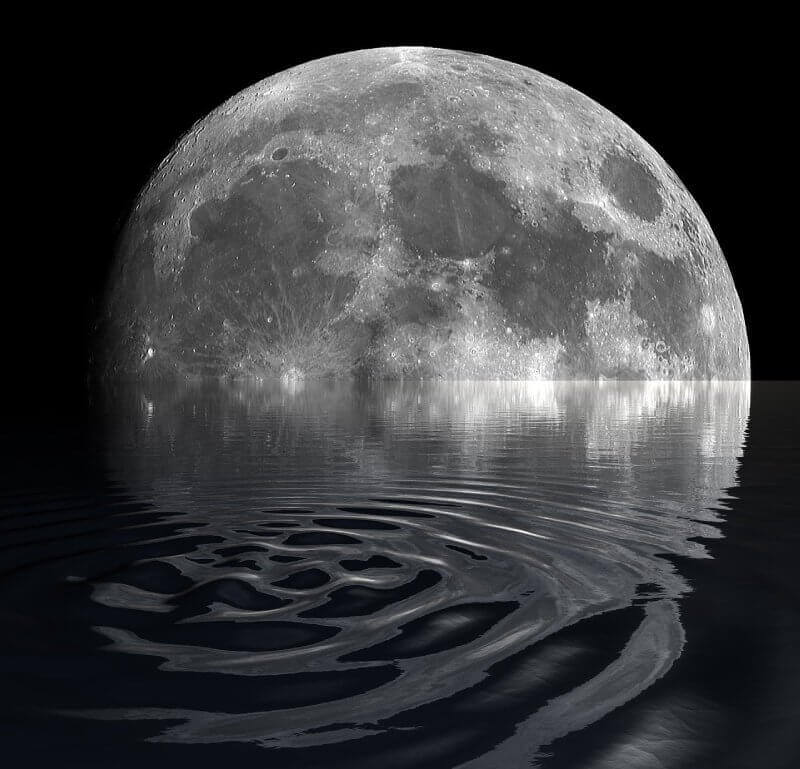Look at the Moon when it’s visible in the sky during the day, and it has a bluish tint to it. Does that mean there’s water on the lunar surface? Well, while there might be water on the Moon, its bluish tint in the daylight is just an optical illusion, not an indicator of water on its surface.
Does The Moon Have Water?
NASA scientists suspect there might be water on the Moon, but they’re unsure how much there is and its location. A research paper released in 1967 by Harold Urey scoffed at his colleague’s assumptions that the river-like channels on the lunar surface were carved by anything other than water.
However, the discovery of lunar water in 2008 by the Indian Space Agency (ISRO) and its Chandrayaan-1 spacecraft proved that water was a feature of the Moon. Chandrayaan-1 carried a NASA instrument, the Moon Mineralogical Mapper (M3), which observed how the lunar surface absorbs infrared light.
The data from M3 showed water molecules found in ice inside the polar craters on the lunar surface. In 2008, NASAs Lunar Reconnaissance Orbiter (LRO) and its probe, LCROSS, took up a mission to the Moon, with the rocket’s upper stage deliberately crashed into a crater on the Moon’s southern pole.

LCROSS navigated through the plume of debris, detecting over 340 lbs of water before crashing into the lunar surface itself. Since the discovery, other lunar missions have noticed water in different regions of the Moon.
In 2020, the German Space Agency and NASA used the SOFIA telescope to observe the presence of water on the lunar surface.
How Is It Possible for the Moon to Have Water?
It might seem strange that there is water on the lunar surface. After all, the Moon has no atmosphere and exists in the vacuum of space. The daytime temperatures on the sun-facing side of the Moon reach a toasty 248F, and surface water evaporates and floats away.
Earth has a 23-degree tilt from the plane in which other planets in the solar system orbit around the Sun. The angle changes the sunlight reaches the southern and northern hemispheres on Earth and creates the seasons on our planet. It’s also responsible for prolonged darkness and daylight in lands near the north and south poles.

The Moon, however, doesn’t have the same degree of tilt. At the poles on the lunar surface, the Sun sits close to the horizon. Large lunar craters with rims block the sunlight from reaching inside the crater. These “PSRs” or Permanently Shadowed Regions exist on other planets with low brevity, such as Mercury.
The temperatures inside PSRs on the lunar surface can drop as low as -418F, making them colder than the surface of Pluto. Good thing astronauts have special suits and advanced equipment to deal with temperatures on the Moon! The Moon’s southern and northern poles also feature plenty of PSRs where NASA spacecraft detected the presence of water ice.
How Much Water is on the Moon?
Radar technology aboard Chandrayaan-1 and LRO showed the southern and northern lunar poles are home to more than 1.3 trillion pounds of water ice. This water could fill approximately 240,000 Olympic-sized swimming pools.
NASA states this is a low estimate due to the limitations of spacecraft radar. In 2020, researchers identified PSRs inside lunar craters containing space ice using LRO data. The research shows there could be 10% to 20% more water ice on the Moon than previously estimated.
Where Did the Water in the Moon’s Craters Originate?
Water possibly arrived on the Moon due to impacts from water-bearing asteroids and comets. Some of these bodies smashed into the Moon, depositing water. According to the “Big Splash” theory of the formation of the Moon, some of the water on the lunar surface may be from Earth.
While most of the water on the lunar surface evaporated, some wound up in PSRs, where it remains billions of years after the event. In the non-polar regions of the Moon, solar wind consisting of protons emitted by the Sun bombard its surface.
The protons reaching the lunar surface interact with oxygen molecules to create water. You can’t drink this water because it’s in small quantities in the soil, which is hundreds of times drier than the sand in the Sahara Desert.
Why Are Scientists Interested in Water on the Moon?
Space scientists plan to use the water on the lunar surface to create drinking water, fuel, and air for future space missions to the Moon.
The water, ice, and chemicals found in PSRs offer scientists an accurate record of asteroid and comet bombardment on our satellite from the solar system’s early days and the formation of the Earth and the Moon.
How Will Lunar Missions Study Water on the Moon?
Over the last decade, space missions collected more data on the Moon’s PSRs to serve in lunar rover missions. Using data from Japan’s Kaguya orbiter and LRO allowed NASA to identify safe and useful landing sites for future moon missions.
LRO data also assisted with mapping an atlas of PSRs, with high-resolution slope and altitude maps, along with images created by dim light illuminating the upper walls of craters on the lunar surface. The Chandrayaan-2 orbiter, launched in 2019, uses its advanced radar mapping to identify and quantify water ice.
The NASA Trailblazer orbiter, launched in 2023, will assist Chandrayaan-2, and the NASA ShadowCam onboard South Korea’s lunar orbiter, launched in 2022. China’s Chang’e-6 mission sent to the Moon will also bring water ice samples back from the south and north lunar poles.

The samples offer scientists a way to date chemicals locked inside the ice, providing data on the solar system’s history. Due to launch in 2024, the NASA VIPER mission intends to drive into lunar PSRs to create maps of water ice and drill to find out what’s hiding in its depths.
The VIPER findings provide data for the upcoming ARTEMIS program, which NASA intends to use to pave the way for the eventual colonization of the Moon. The parameters for the ARTEMIS II mission state NASA plans to sample materials in PSRs and bring them back to Earth for study.
Wrapping Up
According to NASA, there are over 1.3 trillion pounds of water ice on the lunar surface, and possibly a lot more. Future lunar missions intend to improve on previous results to get an accurate measurement of water ice on the Moon.

